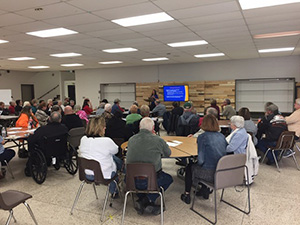Partnerships for Environmental Public Health (PEPH)
Study Location: State of Michigan
Academic Partners:
Emory University
Michele Marcus, Ph.D.
Alma College
Community Partners:
Polybrominated Biphenyls (PBB) Citizen’s Advisory Board
Pine River Superfund Citizen Task Force
Mid-Michigan District Health Department
PBB community members and affected residents
Project Description

Michele Marcus, Ph.D., (pictured in front) presents research findings and answers questions during a community meeting in Fremont, MI in December 2017.
(Photo courtesy of Michele Marcus, Ph.D.)
This project builds on the Michigan Polybrominated Biphenyl (PBB) Registry, an initiative established in 1976 to study the health of thousands of people who were exposed to brominated flame retardants as a result of the largest agricultural disaster in U.S. history. This disaster was a result of the Velsicol Chemical Company’s accidental shipment of a flame retardant mixture in place of a nutritional supplement for livestock feed in 1973, which introduced PBB into the Michigan food chain, ultimately exposing millions of Michigan residents.
The Registry now contains a multigenerational cohort of 8,000 individuals, which includes those exposed during the contamination incident as well as subsequent generations. This cohort has been followed for more than 40 years, where investigators are evaluating the long-term health effects of exposure to PBB.

Michele Marcus, Ph.D., (pictured third from right in front) and Emory University colleague Melanie Pearson, Ph.D. (pictured second from left in front) pose with other partners and representatives from Alma College, the Mid-Michigan District Health Department, the Pine River Superfund Citizen Task Force, and the PBB Citizen Advisory Committee during a partner retreat in Ithaca, MI.
(Photo courtesy of Michele Marcus, Ph.D.)
Through an existing partnership between scientists, community partners, and public health officials, this project seeks to address several concerns expressed by the PBB community and will include development of a public health action plan to raise environmental health awareness in Michigan.
Specific project aims are to:
- Evaluate the utility of a nutritional supplement as a treatment and means of accelerating the body’s elimination of PBB through a randomized controlled trial.
- Explore the heritability of epigenetic marks associated with PBB exposure by studying 25 families across multiple generations.
- Collect health questionnaires and serum samples from study participants to determine if PBB exposure is associated with other health effects, such as neurodegenerative diseases, joint pain/disorders, cancer, immune dysfunction, and liver or pancreatic problems.
- Develop and use a public health action plan to communicate scientific information to community members, health care providers, and policy-makers to increase local awareness and capacity to address exposure concerns.


